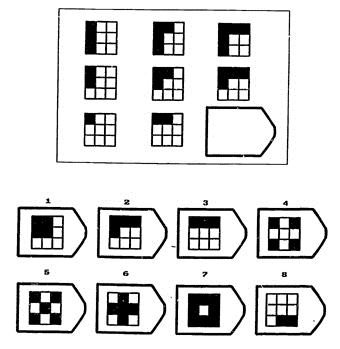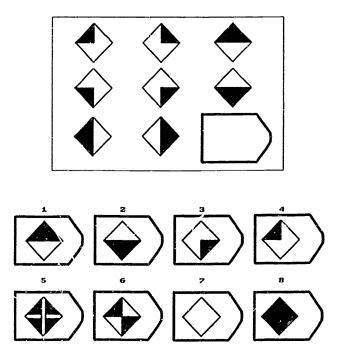- An explanation of what matrices IQ tests are and how they are used
- A closer look at the different types of Raven Matrices tests
- A basic tutorial on strategies to solve Raven’s Advanced Progressive Matrices Test problems, with examples
Matrices IQ tests
A matrices IQ test is a non-verbal ‘culture fair’ multiple choice IQ test, that measures your fluid intelligence (Gf) – your reasoning and problem solving ability. Fluid intelligence is a core component of g – your general intelligence. In each test item, the subject is asked to identify the missing element that completes a pattern of shapes. The patterns are presented in the form of a 4×4, 3×3, or 2×2 matrix, giving the test its name. An example of a matrices test is shown here, from Smart-kit.com.
 Because of the simplicity of their use and interpretation, and their independence of language and reading and writing skills, Matrices tests have widespread practical use – as a measure of intelligence in the general population for both adults and children, for job applicants as a psychometric test, for applicants to the armed forces, and for assessing clinical (e.g. autistic) populations.
Because of the simplicity of their use and interpretation, and their independence of language and reading and writing skills, Matrices tests have widespread practical use – as a measure of intelligence in the general population for both adults and children, for job applicants as a psychometric test, for applicants to the armed forces, and for assessing clinical (e.g. autistic) populations.
Matrices IQ tests measure fluid intelligence (Gf)
Fluid intelligence – is the ability to reason and solve problems using new information without relying on previously acquired knowledge and skills. The ability to deal with novelty, to adapt one’s thinking ‘fluidly’ to a new, unfamiliar problem. Fluid intelligence is contrasted with crystallized intelligence which is previously acquired knowledge and skills that have become ‘crystallized’ with experience. Matrices IQ tests measure fluid intelligence. Because there is a high correlation between fluid intelligence and general intelligence (g), matrices tests are often used as a general IQ test – for overall cognitive ability.
Raven Matrices Test
Matrices tests were originally developed by John C. Raven back in 1936. The Matrices are available in three different forms for participants of different ability:
- Standard Progressive Matrices: These were the original form of the matrices, first published in 1938. The 60 problems in this test get increasingly difficult, demanding greater cognitive capacity to solve .
- Coloured Progressive Matrices: Designed for children aged 5 through 11 years-of-age, the elderly, and mentally and physically impaired individuals. This test contains questions from the standard matrices, as well as other test items.
- Advanced Progressive Matrices (RAPM): The advanced form of the matrices test contains 48 problems. These items are appropriate for adults and adolescents of above-average intelligence.
“Parallel” forms of the standard and coloured progressive matrices were published in 1998 – to address the problem of the Raven’s Matrices being too well-known in the general population.
Cattell Culture Fair Intelligence Test (CFIT) – III
The CFIT (or ‘Cattell’) IQ test has four kinds of problems – series completion, classification, matrices and conditions. These should all be self-evident for the easier problems below. For the ‘conditions’ type problem there are different elements such as “dot”, “circle”, “square”, and a set of relationships that need to be figured out – such as “inside”, “outside”, “not”, “and”. The object is to figure out the something like “dot inside circle and outside square” (making 3 the only viable answer below).

High IQ Societies & Matrices IQ Tests
Generally, there are two ways to prove that you qualify for Mensa: either take the Mensa test, or submit a qualifying test score from another test. There are a large number of intelligence tests that are “approved”, including the Cattell Culture Fair Test (IQ score 148). The Triple Nine Society, a high IQ society, accepts the Advanced Progressive Matrices for one of their admission tests. They require a score of at least 32 out of 36 on or before December 31, 1999 on the RAPM.
The International Society for Philosophical Enquiry (ISPE) and International High IQ Society also accept the RAPM as a qualification for admission. The Triple Nine Society is a high IQ society that uses the CFIT-III as one of their tests for admission. A combined raw score of 85 on forms A and B is required for admission; however, the Triple Nine Society (TNS) does not accept this score if taken after September, 2008. Also, the TNS accepts the Cattell Intelligence (verbal) test, Scale IIIB, qualifying score of 173, but again, not if taken after September, 2008
How To Use Strategies To Get A High Score On A Raven Matrices Test
Each Raven test has the same format: a 3 x 3 matrix in which the bottom right entry is missing, and must be selected from 8 alternatives. Solving Raven’s matrices type problems essentially requires figuring out the underlying rules that explain the progression of shapes. Here is an example to try to figure out:
The correct answer is 5. The variations of the entries in the rows and columns of this problem can be explained by 3 rules.
1. Each row contains 3 shapes (triangle, square, diamond).
2. Each row has 3 bars (black, striped, clear).
3. The orientation of each bar is the same within a row, but varies from row to row (vertical, horizontal, diagonal).
From these 3 rules, the answer can be inferred (5).
Raven’s Advanced Progressive Matrices Test: The Underlying Rule Set
John Raven designed all the problems for his IQ tests to be based on a limited number of rules making up a well-defined rule-set. Each problem might have combinations of different rules or different instances of the same rule. In order to solve Raven’s Advanced matrices problems effectively, you will benefit from learning these rules.
Here are some of the key rules:
1. Constant in a row. This is ‘rule 3’ in the matrix example above – the orientation of the bar is the same in each row, but changes down a column.
2. Quantitative progression. An increase or decrease between adjacent entries in size, position or number. An example of this rule is shown below:
The correct answer is 3. The number of black squares in each entry increases in the top row from 1 to 2 to 3. Similarly, the number of black squares in the first column decreases from 3 to 2 to 1.
3. Figure addition or subtraction. A figure from one column is added to or subtracted from another column to produce the third. An example is given below:
Correct answer 8
Your score on a matrix IQ test will give you a ‘culture fair’ measure of your IQ level. IQ scores are distributed like a ‘bell curve’ around an average of 100. An IQ score of >115 is considered a high IQ. An IQ score of 130 is Mensa standard.



where do i get iq tests for free?
Karen Leveille, i solved the logic puzzle.
In response to: “Hmm actually the last question with the triangles… Although it says the answer is 8. The horizontal and vertical additions should negate and you therefore 7 would be more correct. But then again that may be thinking too deep and unnecessarily”…
They’re adding up the black shaded parts (and not the white parts) if you go horizontally or vertically – therefore the only correct answer to the last question is 8
Can anyone here help me solve this puzzle? https://www.brainzilla.com/logic/zebra/travel-agency/ I can solve raven matrices easily but I can’t for the life of me solve this puzzle without guessing.
Anonymous December 08, 2015… Yes, your way of looking at it (addition, with negation and flip) is correct, but it is more complex than necessary. The simplest solution, simply addition, is “more correct.” There is also a third way of looking at it, intermediate in complexity, that would also be correct; but, again, not the simplest solution.
What is the formula to calculate the IQ on the Ravens CPM
RE: “Hmm actually the last question with the triangles… Although it says the answer is 8. The horizontal and vertical additions should negate and you therefore 7 would be more correct. But then again that may be thinking too deep and unnecessarily.”
…If you look at it this way: Start with the top left corner shape, this shape plus either the shape to the right of it OR the shape below it equals the third shape in either direction (as in if they were glass panels and were overlayed where the white is clear). The idea of the white over-riding the black could not be possible as there are no other instances of that occuring, no evidence to think that could happen.
Aaron, I think your Step 3 misses the real pattern. In addition to your first two Steps, which are correct, each type of shape (line, block, curve) must appear once in the vertical component per row and once in the horizontal component per row. In the bottom row, lines have not appeared (yet) in the vertical and blocks have not appeared (yet) in the horizontal. Thus, answer #5 as as identified long ago
The answer to the first question is defiantly option 2.
Here’s the proof.
_____
STEP 1
……………………..
Row 1 Horizontal = 1,3,2
Row 2 Horizontal = 3,2,1
Row 3 Horizontal = 2,1,?
…………………….
-> ANSWER must have three horizontal lines
Options are (two, three, four, five, eight)
_______
STEP 2
………………….
Row 1 vertical = 2,1,3
Row 2 vertical = 3,2,1
Row 3 vertical = 1,3, ?
…………………
-> ANSWER must have two vertical lines
Options still (two, three, four, five, eight)
______
STEP 3
………………..
look at the vertical (downwards) direction of those boomerang arrows.
……………….
Row 1 vertical = Left, none, up
Row 2 vertical = Up, none, left
Row 3 vertical = none, left, ?
……………..
-> ANSWER must have up facing boomerang arrows
Options one and two
–>> process of elimination. Answer can’t be option 1 because it does not meet step 1 or 2. The only logical answer is option 2.
Note: I tried imagining it as a slot machine and how each pieces moved one or two places between vertical row 1,2,3 but couldn’t seem to pick a pattern. I think there might be something there also?
No wait. 5 does have an extra logical edge.
The correct answer to the first question is 2: 2 up and down straight thin lines with three curved lines intersecting. I an provide an explanation if needed.
last question, all contain black, answer #7 has no black
Hmm actually the last question with the triangles… Although it says the answer is 8. The horizontal and vertical additions should negate and you therefore 7 would be more correct. But then again that may be thinking too deep and unnecessarily.
the answer to the one at the top is 5
MMH – would be Mild-Moderate Mentally Handicapped
Is 5
||
=
=
=
I would like to know what the result means “She has an IQ that lays on the border of MMH”
I am a teacher and one of my students was tested by a school pshyciatrist. I must discuss it with the parents but do not know what that statement means
Thanks
not all have answers
Is the ans # 2
Comments are closed.